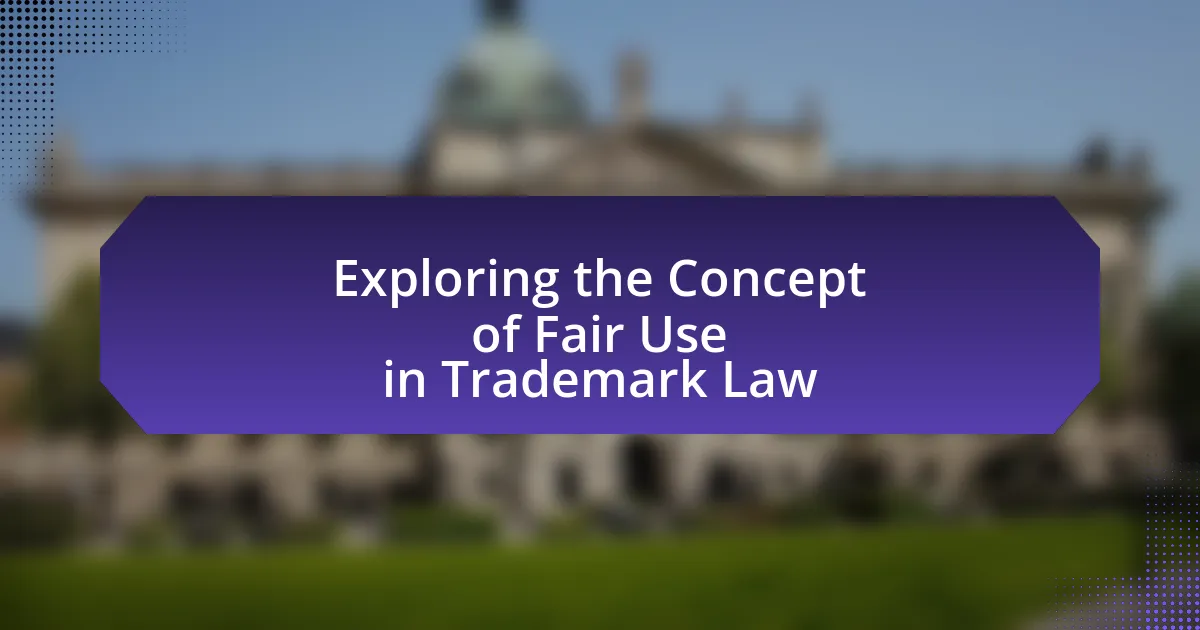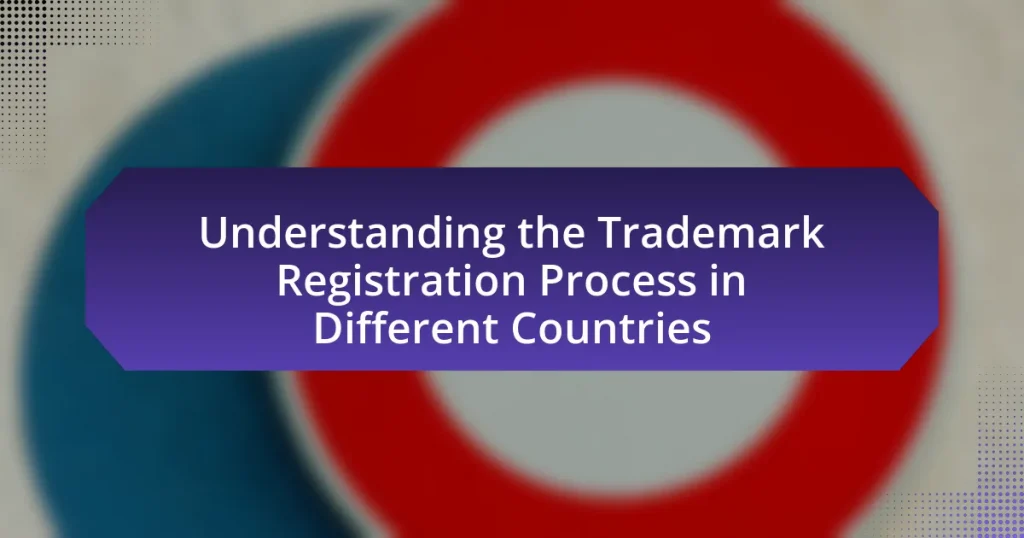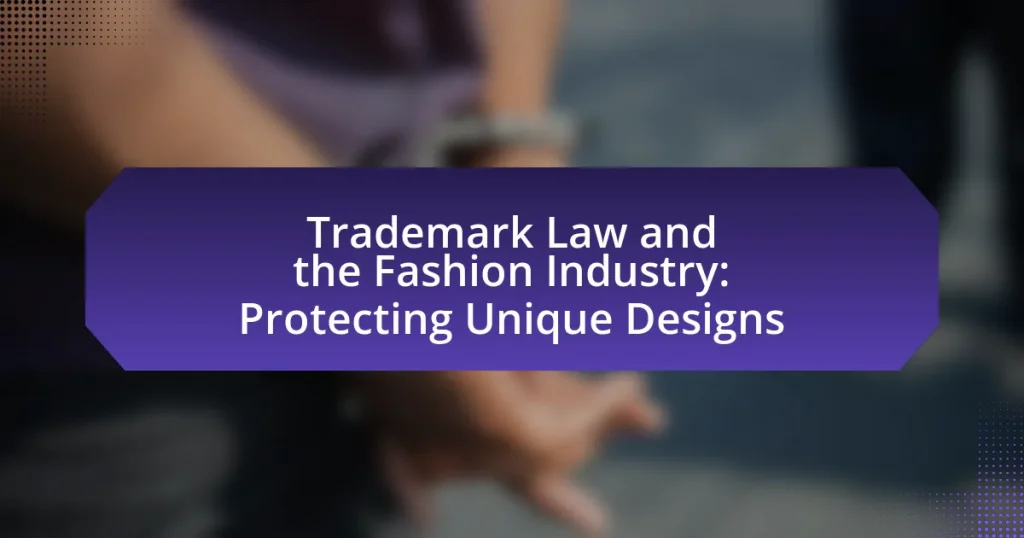Fair use in trademark law is a legal doctrine that permits limited use of a trademark without the owner’s permission, primarily for purposes such as commentary, criticism, or comparative advertising. This article explores the definition and significance of fair use, the legal standards for determining its applicability, and the distinctions between descriptive and nominative fair use. It also examines how courts evaluate fair use claims, the impact of fair use on competition and free speech, and common misconceptions that businesses may have regarding fair use. Key cases and best practices for compliance are discussed to provide a comprehensive understanding of fair use in the context of trademark law.

What is Fair Use in Trademark Law?
Fair use in trademark law refers to the limited use of a trademark without permission from the trademark owner, typically for purposes such as commentary, criticism, or comparative advertising. This doctrine allows individuals or entities to use a trademark in a way that does not confuse consumers about the source of goods or services, thereby protecting both the trademark owner’s rights and the public’s interest in free expression. Courts evaluate fair use claims based on factors such as the purpose of the use, the nature of the trademark, and the likelihood of consumer confusion, as established in cases like Mattel, Inc. v. MCA Records, Inc. where the court recognized that artistic expression could qualify as fair use.
How is Fair Use defined within the context of trademark law?
Fair Use in trademark law is defined as the limited use of a trademark without permission from the trademark owner, typically for purposes such as commentary, criticism, or comparative advertising. This doctrine allows for certain uses of a trademark that do not cause confusion among consumers regarding the source of goods or services. Courts evaluate Fair Use claims based on factors such as the purpose of the use, the nature of the trademark, and the likelihood of consumer confusion, as established in cases like Mattel, Inc. v. MCA Records, Inc., where the Ninth Circuit ruled that artistic expression could qualify as Fair Use.
What are the legal standards for determining Fair Use?
The legal standards for determining Fair Use are established by a four-factor test outlined in Section 107 of the U.S. Copyright Act. These factors include: the purpose and character of the use, the nature of the copyrighted work, the amount and substantiality of the portion used, and the effect of the use on the market for the original work. Each factor is evaluated to assess whether the use qualifies as Fair Use, balancing the interests of copyright holders with the public’s interest in the use of creative works. Courts have consistently applied this test in various cases, such as Campbell v. Acuff-Rose Music, Inc., which emphasized the importance of transformative use in determining Fair Use.
How does Fair Use differ from other trademark defenses?
Fair Use differs from other trademark defenses primarily in its focus on the purpose and character of the use rather than the likelihood of confusion among consumers. While traditional trademark defenses, such as descriptive fair use or nominative fair use, often hinge on whether the use of a trademark creates confusion about the source of goods or services, Fair Use allows for the use of a trademark in a transformative manner, such as commentary, criticism, or parody, without necessarily considering consumer confusion. This distinction is supported by the legal precedent established in cases like Campbell v. Acuff-Rose Music, Inc., which emphasized that transformative use can qualify as Fair Use even if it involves a trademark.
Why is Fair Use important in trademark law?
Fair Use is important in trademark law because it allows for the limited use of a trademark without permission from the owner, facilitating commentary, criticism, and educational purposes. This principle balances the rights of trademark owners with the public’s interest in free expression and the dissemination of information. For instance, the Lanham Act recognizes that descriptive uses of trademarks in comparative advertising can qualify as fair use, promoting competition and consumer awareness. This legal framework ensures that trademark protection does not stifle creativity or restrict legitimate discourse, thereby fostering a dynamic marketplace.
What role does Fair Use play in promoting free speech?
Fair Use plays a critical role in promoting free speech by allowing individuals to use copyrighted material without permission under certain conditions, thereby fostering open discourse and creativity. This legal doctrine enables commentary, criticism, news reporting, teaching, and research, which are essential components of free expression. For instance, the U.S. Supreme Court has recognized that Fair Use supports the public interest by balancing the rights of copyright holders with the need for free access to information, as seen in cases like Campbell v. Acuff-Rose Music, Inc., where transformative use was deemed a valid Fair Use. This balance is vital for a democratic society, as it encourages diverse viewpoints and the sharing of ideas without the fear of legal repercussions.
How does Fair Use impact competition in the marketplace?
Fair Use enhances competition in the marketplace by allowing individuals and businesses to utilize copyrighted material without permission under certain conditions, fostering innovation and creativity. This legal doctrine enables new entrants to build upon existing works, which can lead to the development of new products and services that challenge established players. For instance, the case of Campbell v. Acuff-Rose Music, Inc. (1994) established that transformative use of a work can qualify as Fair Use, thereby encouraging artists to create derivative works that can compete with original content. By reducing barriers to entry, Fair Use promotes a diverse marketplace where competition thrives, ultimately benefiting consumers through increased choices and lower prices.
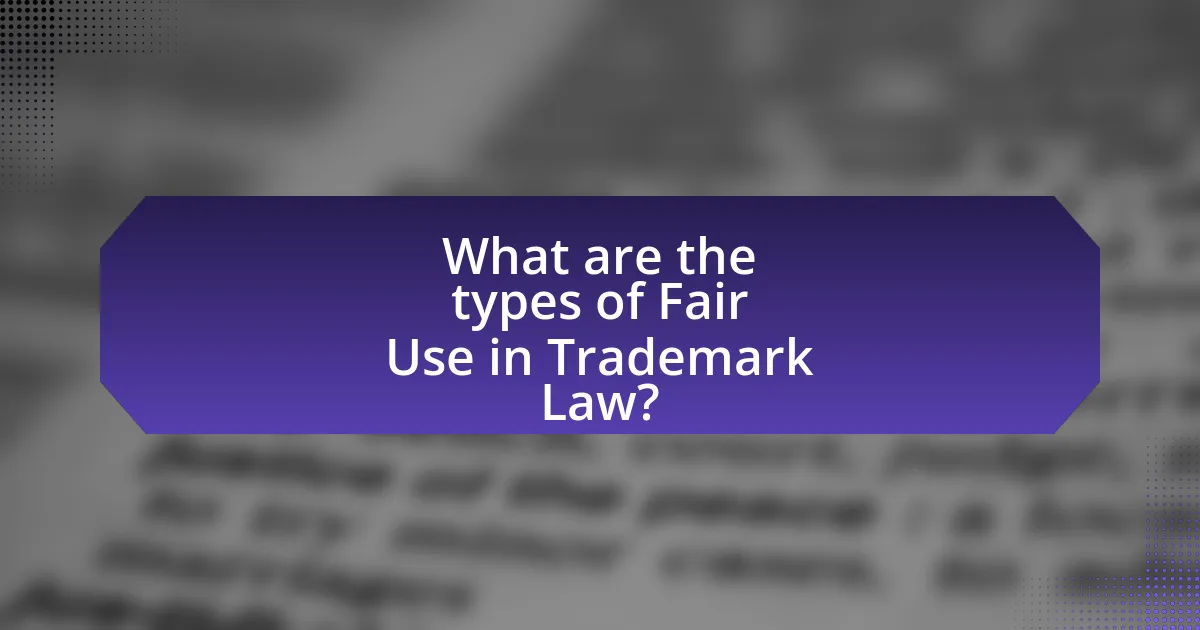
What are the types of Fair Use in Trademark Law?
The types of Fair Use in Trademark Law include descriptive fair use and nominative fair use. Descriptive fair use occurs when a trademark is used to describe the goods or services rather than to identify the source, such as using a brand name to refer to a type of product. Nominative fair use allows the use of a trademark to refer to the trademarked goods or services themselves, provided that the use does not suggest sponsorship or endorsement by the trademark owner. These distinctions are supported by legal precedents, such as the case of New Kids on the Block v. News America Publishing, which established the criteria for nominative fair use.
What constitutes descriptive Fair Use?
Descriptive Fair Use occurs when a trademark is used to describe the goods or services of the user rather than to indicate the source of those goods or services. This type of fair use allows individuals or entities to use a trademark in a way that is not misleading and is necessary for describing their own products or services. For example, using the term “apple” to describe a type of fruit, even if “Apple” is a registered trademark for technology products, constitutes descriptive fair use because it is not intended to confuse consumers about the source of the goods. Courts have recognized this principle in cases such as KP Permanent Make-Up, Inc. v. Lasting Impression I, Inc., where the Ninth Circuit ruled that descriptive use is permissible as long as it does not create a likelihood of confusion among consumers.
How does descriptive Fair Use apply in real-world scenarios?
Descriptive Fair Use allows the use of a trademarked term in a way that describes the goods or services rather than indicating the source. In real-world scenarios, this principle is often applied when a company uses a trademarked term to accurately describe its own products or services, such as a competitor using a brand name to compare features or quality. For example, in the case of “Aspirin,” the term was originally a trademark but became a generic term for acetylsalicylic acid, demonstrating how descriptive use can evolve over time. Courts often evaluate whether the use is purely descriptive and not misleading to consumers, which is supported by the Lanham Act, specifically Section 33(b)(4), that protects descriptive uses when they do not create confusion about the source of the goods.
What are the limitations of descriptive Fair Use?
Descriptive Fair Use is limited by its requirement that the use must be purely descriptive and not suggestive of the trademark owner’s brand. This means that the use cannot create confusion among consumers regarding the source of the goods or services. Additionally, the use must not be for commercial advantage, as any profit-driven motive can undermine the claim of Fair Use. Courts have established that if the descriptive use is not necessary to describe the product or service, or if it is used in a way that implies endorsement or sponsorship by the trademark owner, it may not qualify for Fair Use protection. For instance, in the case of KP Permanent Make-Up, Inc. v. Lasting Impression I, Inc., the court emphasized that the descriptive use must not mislead consumers about the origin of the goods.
What is nominative Fair Use?
Nominative Fair Use is a legal doctrine that allows the use of a trademarked name or logo to refer to the trademarked product itself, without permission from the trademark owner, as long as the use is not misleading. This concept is grounded in the need to balance trademark rights with the public’s ability to accurately describe and identify products. Courts have established that nominative fair use applies when the product is not readily identifiable without using the trademark, the user only uses as much of the mark as necessary, and the use does not suggest sponsorship or endorsement by the trademark owner.
How does nominative Fair Use differ from descriptive Fair Use?
Nominative Fair Use allows the use of a trademark to refer to the trademarked goods or services themselves, while descriptive Fair Use permits the use of a trademark in a descriptive manner to describe the goods or services without implying endorsement. Nominative Fair Use is applicable when the product or service cannot be identified without using the trademark, as established in the case of New Kids on the Block v. News America Publishing, Inc. In contrast, descriptive Fair Use does not require the use of the trademark for identification but rather uses it to describe the characteristics or qualities of the goods or services, as seen in the case of KP Permanent Make-Up, Inc. v. Lasting Impression I, Inc.
What are the key cases that illustrate nominative Fair Use?
Key cases that illustrate nominative fair use include the case of New Kids on the Block v. News America Publishing, Inc., where the court ruled that the use of the band’s name in a survey was permissible as it did not imply endorsement. Another significant case is Mattel, Inc. v. MCA Records, Inc., which established that the use of “Barbie” in a song title was fair use because it was necessary to identify the subject of the song. Additionally, the case of Gordon v. Drape Creative, Inc. highlighted that using a trademark to describe a product is acceptable when it does not create confusion about the source. These cases collectively demonstrate the application of nominative fair use in trademark law, emphasizing the balance between trademark rights and free expression.
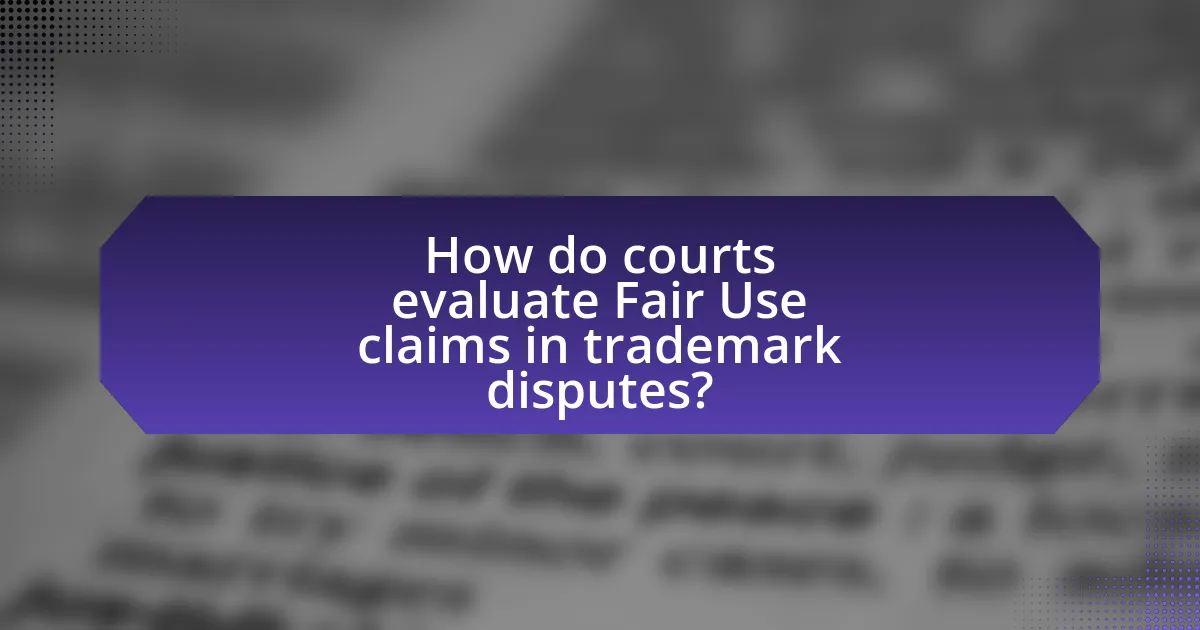
How do courts evaluate Fair Use claims in trademark disputes?
Courts evaluate Fair Use claims in trademark disputes by applying a multi-factor test that considers the purpose and character of the use, the nature of the trademark, the amount and substantiality of the portion used, and the effect of the use on the market for the original trademark. This framework is established in cases such as the Ninth Circuit’s decision in Mattel, Inc. v. MCA Records, Inc., which emphasized that transformative use can support a Fair Use defense. Courts assess whether the use is for commercial purposes or commentary, whether the trademark is distinctive or descriptive, and whether the use harms the trademark’s market value. These factors collectively guide courts in determining if the Fair Use defense is applicable in a given trademark dispute.
What factors do courts consider when assessing Fair Use?
Courts consider four primary factors when assessing Fair Use: the purpose and character of the use, the nature of the copyrighted work, the amount and substantiality of the portion used, and the effect of the use on the market for the original work. The purpose and character factor evaluates whether the use is transformative or commercial, with transformative uses more likely to be deemed fair. The nature of the copyrighted work examines whether the work is factual or creative, as factual works receive more leeway. The amount and substantiality factor assesses how much of the original work was used, with smaller portions generally favoring fair use. Lastly, the market effect factor considers whether the new use harms the market for the original work, with negative impacts weighing against fair use. These factors are derived from the Copyright Act of 1976 and have been reinforced through various court rulings, establishing a framework for Fair Use assessments.
How does the likelihood of confusion factor into Fair Use evaluations?
The likelihood of confusion is a critical factor in Fair Use evaluations, as it assesses whether the use of a trademark by another party creates confusion among consumers regarding the source of goods or services. In Fair Use cases, if the use of a trademark is deemed likely to confuse consumers about the origin of the products or services, it may not qualify as Fair Use. Courts often analyze factors such as the similarity of the marks, the proximity of the goods, and the channels of trade to determine the likelihood of confusion. For instance, in the case of Mattel, Inc. v. MCA Records, Inc., the court found that the use of “Barbie” in a song title did not create confusion, thus supporting a Fair Use defense. This illustrates that a clear distinction between the original trademark and the new use is essential to avoid confusion and uphold Fair Use.
What evidence is typically required to support a Fair Use claim?
To support a Fair Use claim, evidence typically includes the purpose and character of the use, the nature of the copyrighted work, the amount and substantiality of the portion used, and the effect of the use on the market for the original work. These factors are outlined in the U.S. Copyright Act and are used by courts to evaluate whether a specific use qualifies as Fair Use. For instance, transformative use, which adds new expression or meaning, can strengthen a Fair Use argument, as seen in the case of Campbell v. Acuff-Rose Music, Inc., where the Supreme Court ruled that parody can qualify as Fair Use.
What are common misconceptions about Fair Use in trademark law?
Common misconceptions about Fair Use in trademark law include the belief that Fair Use allows any use of a trademark without permission, and that it applies equally to all types of trademarks. In reality, Fair Use is a limited doctrine that permits the use of a trademark under specific circumstances, such as descriptive use or comparative advertising, and does not grant blanket permission for all uses. Additionally, many assume that Fair Use is a straightforward defense; however, it often requires a nuanced analysis of factors like the purpose of use, the nature of the trademark, and the likelihood of consumer confusion. These misconceptions can lead to legal challenges, as the application of Fair Use is context-dependent and varies by case.
How do misunderstandings about Fair Use affect businesses?
Misunderstandings about Fair Use can lead businesses to either overestimate their rights or underestimate the risks associated with using copyrighted material. When businesses incorrectly believe that their use of copyrighted content falls under Fair Use, they may engage in practices that expose them to legal challenges, resulting in costly litigation and potential damages. For instance, a survey by the Copyright Alliance found that 60% of businesses are unsure about the boundaries of Fair Use, which can lead to unauthorized use of protected works, ultimately harming their reputation and financial stability. Additionally, businesses may miss opportunities for legitimate use of content due to fear of infringement, stifling creativity and innovation.
What myths should businesses be aware of regarding Fair Use?
Businesses should be aware that one prevalent myth regarding Fair Use is that it automatically applies to all uses of copyrighted material without permission. This misconception can lead to legal issues, as Fair Use is determined by specific factors outlined in the Copyright Act, such as the purpose of use, the nature of the copyrighted work, the amount used, and the effect on the market value of the original work. For instance, a business might assume that using a small excerpt of a copyrighted text qualifies as Fair Use, but if the use is for commercial purposes and negatively impacts the market for the original work, it may not be protected. Understanding these nuances is crucial for businesses to avoid potential copyright infringement claims.
What best practices should businesses follow regarding Fair Use?
Businesses should follow several best practices regarding Fair Use to ensure compliance with trademark law. First, they should conduct thorough research to understand the specific context of Fair Use, which allows limited use of trademarked material without permission under certain conditions. Second, businesses should evaluate the purpose and character of their use, ensuring it is transformative or non-commercial, as these factors favor Fair Use. Third, they should assess the nature of the original work, recognizing that published works are more likely to qualify for Fair Use than unpublished ones. Fourth, businesses must consider the amount and substantiality of the portion used, aiming to use only what is necessary for their purpose. Lastly, they should analyze the effect of their use on the market for the original work, as a negative impact could undermine a Fair Use claim. These practices align with established legal principles and help mitigate the risk of trademark infringement.
How can businesses ensure compliance with Fair Use standards?
Businesses can ensure compliance with Fair Use standards by conducting a thorough analysis of their intended use of copyrighted material against the four factors established by the U.S. Copyright Act. These factors include the purpose and character of the use, the nature of the copyrighted work, the amount and substantiality of the portion used, and the effect of the use on the market for the original work. For instance, transformative uses that add new expression or meaning are more likely to be considered fair use. Additionally, businesses should document their rationale for fair use decisions and seek legal counsel when in doubt, as this can provide a safeguard against potential infringement claims.
What steps can businesses take to protect their trademarks while utilizing Fair Use?
Businesses can protect their trademarks while utilizing Fair Use by clearly defining the scope of their use and ensuring it aligns with the legal standards of Fair Use. This involves using trademarks in a descriptive manner, avoiding misleading representations, and providing proper attribution to the trademark owner when applicable.
Additionally, businesses should monitor the market for potential infringements and take action against unauthorized uses that could dilute their trademark rights. Legal counsel can assist in drafting clear guidelines for Fair Use applications, ensuring compliance with trademark laws. According to the Lanham Act, Fair Use allows for descriptive use of trademarks as long as it does not create confusion among consumers, reinforcing the importance of clarity in usage.
